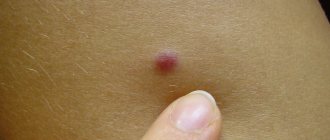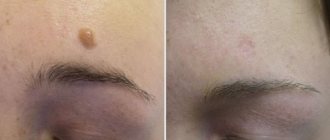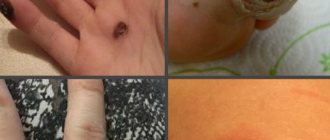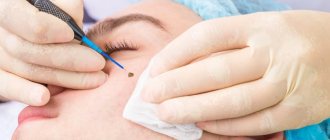Removing moles using a laser is one of the safest ways to get rid of nevus. The entire procedure is carried out according to a clearly defined algorithm. You can avoid complications and unforeseen consequences if you follow the doctor’s recommendations for the next two weeks.
How does the healing process work?
- 3-4 hours after removal of the mole, the wound is covered with a dark dense crust. And after a few hours, the area around it swells and turns red. This is an absolutely normal reaction of the body. The entire healing process lasts from 14 days to a month.
- First week. The scab that appears at the site of the birthmark is prohibited from being torn off. It has a protective function: to protect the wound from infection and allow new tissue to grow. The wound is protected from mechanical damage, friction with clothing, a bath sponge, and scratching. You should also not use cosmetic creams.
Frequently asked question: can a scar or scar appear at the site of a removed mole? Such a nuisance can happen if the protective scab is torn off from the wound surface. Therefore, doctors strongly recommend protecting the wound from outside interference.
- Second week. After about 7-10 days, the dry crust disappears on its own. Instead, a pale pink skin remains. It should not be exposed to sunlight. If the mole was on the face, then use sunscreen with SPF 50. Otherwise, unwanted pigmentation may occur.
- The next two weeks. Usually, by day 20, the site of the removed mole is overgrown with full healthy skin. A slight itching may occur at the wound site, but special skin care is no longer required after getting rid of the birthmark. A month after the operation, the scar from the birthmark will smooth out, and after 2 months only an inconspicuous microscar will remain.
Laser removal of tumors. Possible complications after the procedure
After surgery, you need to carefully monitor the operated area of skin.
Because after surgery, symptoms may appear that require immediate medical attention or additional treatment.
Symptoms:
- Itching, excessive wetting of the wound.
- Bleeding from the wound.
- Heat.
- Pus is released.
- Skin inflammation lasting several days.
Laser removal of tumors. Consequences
It happens that the healing process has slight deviations from the norm, but they can be eliminated with additional treatment.
Let's consider the possible consequences:
- Small blisters on the area of skin where surgery was performed. Occurs when exposed to particularly sensitive skin. Over time, the blisters are replaced by barely noticeable scars.
- The occurrence of hypopigmentation - a light spot forms at the site where the neoplasm was located. Such a defect is a consequence if the removal of the tumor somehow affected the deep layers of the skin and if the rule of prohibiting visiting a solarium and prolonged exposure to the sun is neglected. The white spot will disappear on its own within two years.
- Recurrence of nevus (moles/papillomas). This situation is possible if laser removal of a tumor is performed by an inexperienced specialist and the papilloma/mole is not completely removed. Do not be afraid, this case does not cause harm to health. If the tumor reappears, it can be removed again.
- If the patient has diseases such as herpes and acne, then activation of inflammatory processes is possible.
- The appearance of a depression at the site where the removal was carried out. The situation arises due to the low rate of tissue restoration. The scar is barely noticeable and does not require intervention, since it smoothes out on its own over time.
- The appearance of a bulge at the site where the removal was performed, darker in color than the skin at the site. If this phenomenon does not smooth out within six months, then you need to consult your doctor.
How to care for a wound after mole removal
Sometimes the doctor prescribes treating the scab with disinfectants or ointment with an antimicrobial effect. The most popular care products after mole removal include:
- weak solution of potassium permanganate. It dries out the crust and has an antiseptic effect;
- alcohol solution of brilliant green, or brilliant green. Also a good antiseptic.
Otherwise, routine wound care after mole removal boils down to monitoring the damaged area. Signs of an incorrect healing process will be:
- purulent discharge;
- severe itching, wetness;
- prolonged bleeding;
- increased body temperature;
- noticeable swelling of the skin for several days.
If you notice these symptoms, contact your doctor.
Limitations and complications after laser mole removal
Specific requirements must be strictly adhered to for four weeks after surgery, regardless of how quickly healing occurs. In particular, you should refrain from visiting a solarium and sunbathing, and do not visit the pool or sauna to protect your skin from any infectious diseases. It is also recommended not to drink alcohol, as they dilate blood vessels, often causing bleeding. In case of removal of a mole on the face, you should not apply decorative cosmetics to the skin for 7-10 days after the operation.
Cosmetics with a softening effect speed up the skin restoration process.
As for complications after a laser procedure, they can occur if you do not comply with the doctor’s requirements and do not pay proper attention to the damaged area. In such cases, negative symptoms occur that require immediate contact to the clinic for additional treatment. These complications include:
- prolonged bleeding;
- purulent discharge;
- significant swelling of the skin that does not go away for several days;
- increased temperature of the whole body or area around the wound;
- severe itching.
What restrictions exist after the procedure?
- In the first three to five days after the procedure, alcohol is excluded from the diet. Alcoholic drinks dilate blood vessels, increasing the likelihood of bleeding.
- For two weeks after laser removal of a birthmark, you should avoid contact with water. It is recommended not to visit the bathhouse, sauna, or swimming pool.
- You will have to protect your skin from sunlight and solarium lamps for a whole month. This will save you from possible hyperpigmentation.
If you follow simple wound care rules after mole removal, recovery will be quick and painless.
How to get rid of moles
If moles begin to bother you and cause discomfort, and the doctor says that they need to be removed, then they need to be removed as quickly as possible. The most important thing you shouldn’t do is try to get rid of a mole, and especially a troublesome mole, on your own in “makeshift” conditions. Independent “operations” are strictly prohibited, as they can cause complications: blood poisoning or large blood loss, because there is a chance that you simply will not be able to stop the flow of blood if you disturb or damage the mole.
Pharmacies sell celandine-based preparations designed to remove warts. Some believe that they can safely remove moles. However, this is a big misconception. Firstly, these tinctures can seriously burn the skin around the mole, leaving extensive scars, and secondly, they can disrupt the very structure of the mole, which can lead to the rapid development of skin cancer. It is also not recommended to carry out the procedure for removing moles in beauty parlors and beauty salons, unless they have certified and qualified dermatologists and oncologists.
There are several methods for removing moles (surgical, electrocoagulation, cryodestruction, laser evaporation. The choice of method for removing moles is usually based on the characteristics and condition of a particular mole, as well as the degree of possible threat to the body. If we take the general case of non-troublesome moles, according to According to many experts, the most effective in all respects is the laser method of mole removal.
The laser removal procedure looks like this: local anesthesia is applied to the treatment area, and then, using modern lasers, the surface of the mole is gradually processed, evaporating its layers one by one. The high accuracy of such operations is ensured by the latest laser technologies - you can control the depth of exposure and set the required beam diameter. Why is this method so popular among doctors? Its first and main advantage is the complete absence of any even the slightest bleeding, the complete elimination of the possibility of contamination of the treated surface with various microbes and infections , since laser treatment is a non-contact procedure. Well, important factors are the aesthetic side and the time spent on the removal process itself, as well as the recovery period of the treated area of skin. The laser “operation” itself lasts less than 5 minutes, and the recovery period of the skin in the treatment area does not exceed 2-3 weeks. Moreover, after complete healing and regeneration of the skin, practically no traces remain at the site of the former mole.
How are moles removed with laser?
The content of the article
The procedure is carried out under local anesthesia - before removing the mole, the doctor administers local analgesics. The effect of the drug lasts from half an hour to 3 hours. After the procedure, a wound remains, which, depending on the size and location of the removed mole, heals in 2-4 weeks.
After the procedure for removing the bandage, the doctor writes a prescription for an ointment, which must be used at home until healing. This prevents infection and provides a beautiful aesthetic appearance and helps prevent scarring. Depending on the size and location of the mole, the procedure takes 10-15 minutes, and several moles can be removed in one visit.
The laser, which is used to remove moles or other skin lesions, works on the principle of evaporating water from cells. This means that water evaporates from the affected cells and the cells die, while the surrounding tissue remains intact. True, in some cases, a post-procedure wound on the skin caused by heating may seem deeper than it actually is, but after a few days everything returns to normal, and the skin defect fills in during the healing period and leaves a small spot.
The effect of laser on moles
The surgical laser used for mole removal (and other soft tissue procedures) is highly accurate and is by far the best choice for this type of procedure.
When should a mole be removed?
Women often resort to laser removal of moles in Moscow for aesthetic purposes or to get rid of discomfort - the birthmark is located in places where it can be easily damaged. There are cases of degeneration into melanoma. Here, medical intervention is vital.
Indications
It is better to get rid of lumpy and hanging tumors if there is a danger of injuring them or if they spoil the appearance. In addition, the specialist will recommend resorting to medical intervention when signs of possible degeneration are discovered:
- the color of the spot has changed;
- grows quickly;
- ichor discharge appeared;
- peeling and itching began.
Contraindications
There are cases when the nevus cannot be touched at all, or the session is temporarily postponed. For example, during menstruation in women. Manipulation is also contraindicated for people who:
- severe heart disease;
- poor blood clotting;
- there are skin infections.
What can inflammation lead to?
Purulent discharge always indicates the development of a bacterial or fungal infection. They are dead cells that the body wants to get rid of. The accumulation of pus under a mole can be provoked by:
- its damage and further infection of the wound,
- any skin infection that has spread to a pigmented area.
Suppuration of a nevus is very dangerous, as it can increase the risk of malignancy of its cells. Inflammation of the skin in this area can also be a symptom of melanoma that has already begun to develop. Only an experienced dermatologist can determine what exactly triggered the inflammatory process.
Is it possible to remove all moles with laser?
During the consultation, when a patient requests removal of a mole, the doctor carefully examines the mole and selects the most suitable removal method. If the mole has no lesions and dermatoscopy or siascopy does not reveal signs of atypia, removal for medical purposes is not required.
In this case, the removal of a mole is carried out only when the patient wishes it for aesthetic or comfort reasons, and in each case the method of removing a specific mole is selected individually. However, even unchanged moles are recommended to be removed if they are often injured by clothing, jewelry, shaving, and so on.
Moles are usually removed with a laser after administration of local analgesics. Laser mole removal is a quick procedure and the wound heals faster than surgical removal as there are no stitches, so a better cosmetic result is achieved. In addition, the likelihood of postoperative complications is much lower.










